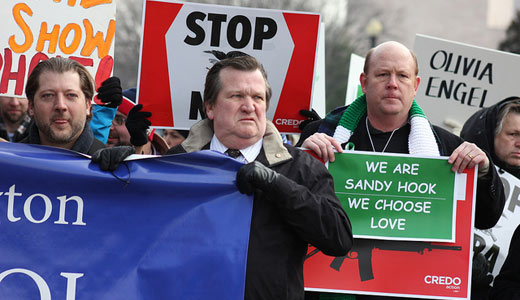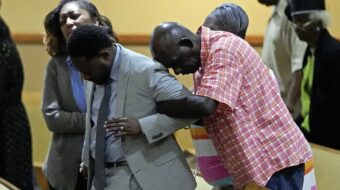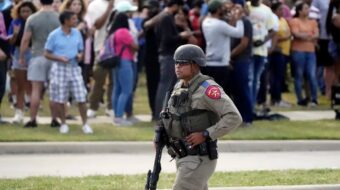
At the Jan. 30 Congressional hearing on legislation to curb gun violence NRA spokesman Wayne LaPierre repeated the mantra of the right wing extremist movement:
“I think without any doubt, if you look at why our Founding Fathers put (the Second Amendment) there, they had lived under the tyranny of King George and they wanted to make sure that these free people in this new country would never be subjugated again and have to live under tyranny.”
This is a complete fairy tale but unfortunately, as a result of a 36-year campaign by the National Rifle Association, it is widely accepted including among some progressive people. Just the previous week former Congressman Dennis Kucinich, now a commentator on Fox News, shocked and delighted Sean Hannity when he stated, “the people are weaponizing themselves historically because – you go back to the beginning of the Constitution – it was to protect themselves against a tyrannical government. So now, with the government getting ever more powerful, people weaponize themselves.
It is disheartening to say the least that such a progressive and intelligent person as Kucinich has fallen for the fraudulent position of the ultra-right.
The theory that the Second Amendment was enacted to protect individual gun ownership and the right to resist or overthrow the government is known in legal circles as the “insurrectionist” interpretation. It was never taken seriously by any court or legal scholars until the NRA was taken over by extremists in 1977 and began a campaign at the behest of gun manufacturers to repeal all gun control legislation. Former Chief Justice Warren Burger, a conservative appointed by Pres. Richard Nixon, denounced this effort in no uncertain terms. The Second Amendment, he said in 1991, “has been the subject of one of the greatest pieces of fraud – I repeat the word ‘fraud’ – on the American public by special interest groups that I have ever seen in my lifetime.”
A thorough and highly informative rebuttal of this “insurrectionist” interpretation can be found in an article, “The Hidden History of the Second Amendment,” by law professor Carl T. Bogus that appeared in the University of California Davis Law Review in 1998. Here is the link.
Bogus showed that James Madison, author of the Second Amendment, was motivated by the concern of slave owners, like himself, that the Constitution could empower the federal government to disarm state militia in the South that were essential for preventing and suppressing slave revolts. The amendment was a concession to the powerful opponents of the Constitution like Patrick Henry, who feared the new document would permit Congress by these means to subvert and abolish slavery.
It was adopted to reassure Southern states that the federal government could not interfere with their ability to muster and maintain an armed force to secure slavery.
The Amendment reads: “A well regulated militia being necessary for the security of a free state, the right to keep and bear arms shall not be infringed.”
There was no public clamoring for the right of individuals to own guns for self defense and there certainly was no support among the Framers – slave owners in the South, bankers, large land owners and merchants in the North – for authorizing armed resistance to actions of the federal government. In fact, the Founding Fathers were virtually unanimous in supporting the violent suppression of Shay’s Rebellion in 1787, a revolt by disenfranchised small farmers, shopkeepers and hired workers in Western Massachusetts, being driven into foreclosure and debtor’s prison by Boston banks.
Madison called the revolt “treason” and urged Congress to send troops to help the State militia. John Hancock, elected governor to deal with the rebellion, mobilized troops with instructions to “kill, slay and destroy, if necessary, and conquer by all fitting ways, enterprises and means whatsoever, all and every one of the rebels.”
The suppression of the rebellion was heartily endorsed by George Washington, Benjamin Franklin, Samuel Adams and John Marshall. Only Thomas Jefferson, then living in Paris as U.S. Ambassador to France, temporarily floated the idea of the right of revolution before realizing that he was alone in his views.
Later in 1794, a similar revolt by small farmers in Western Pennsylvania, known as the Whiskey Rebellion, was suppressed by Pres. George Washington, who under the provisions of the new constitution, led 13,000 troops mobilized from four state militia to disperse the rebels.
The Founding Fathers limited the franchise to white males with property over the age of 40 – approximately 15% of the population. If they were unwilling to arm ordinary people with votes to change the government, they certainly were not for arming them with guns.
Thus, the “insurrectionist” twisting of the Second Amendment has no basis in history. It is a fantasy promoted by reckless profiteers and delusional right-wing extremists.
It should be noted that while the proliferation of guns has reached record levels of over 300 million, the number of households possessing them has sharply declined from 54% in 1977 to 32% in 2010 according the Univ. of Chicago General Social Survey. Fewer people are amassing more guns and the study found that these new gun buyers are primarily Republicans. In fact, 50% of adult Republicans now own guns, but only 22% of adult Democrats.
The fight to end gun violence is not only a matter of public safety. It is an essential part of the fight to secure democracy from right wing extremism.
Photo: March on Washington for Gun Control. Elvert Barnes // CC 2.0










